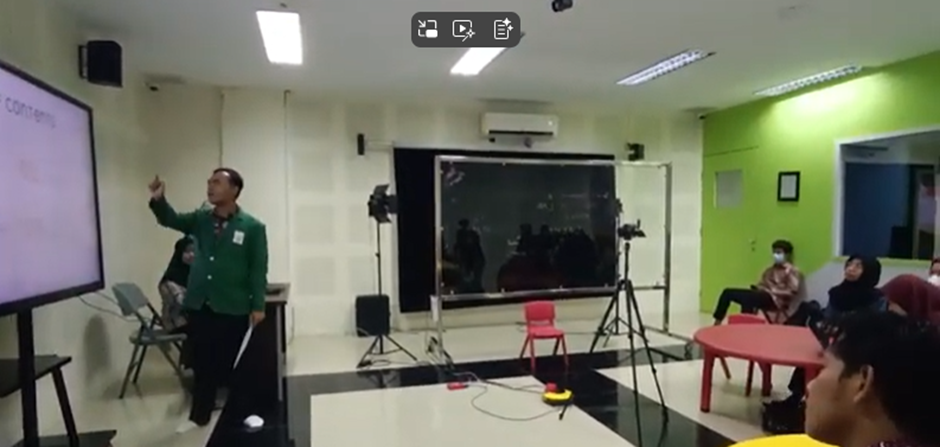This study was conducted by Dr. Tiyas Saputri, S.S., M. Pd. with her team of lecturers and students of S1 English Education Department of Universitas Nahdlatul Ulama Surabaya which focused on the autistic student in teaching practicum on January-October, 2025. This study was entitled ” The Implementation Of Video Recording And E-sorogan Learning Method For The Autistic Student In Teaching Practicum.” This study aimed to find out the implementation of video recording and E-Sorogan learning method for the autistic student in teaching practicum and the advantages and challenges for the autistic student as the pre-service teachers in teaching practicum. The student is diagnosed with Autism. With these two methods (video recording and e-Sorogan learning methods), his English teaching performance during teaching practicum was recorded. After being recorded, his English teaching materials and his English teaching performance role play videos are uploaded in e-Sorogan.
The results of the study illustrated the autistic student teacher’s implementation of using video recording and e-Sorogan learning methods in microteaching. The autistic student created interactive videos, including presentations and role-play conversations, to express freely while still adhering to the instructions given by the lecturer. The videos are also tailored to the topics determined by the lecturer. This interactive video method helps students better understand the lecture material. Furthermore, when group assignments are required, the student must be able to interact effectively with his group mates, thereby improving his interaction skills with other classmates. When recording videos, students can use e-Sorogan tablets to record their lessons, maximizing the use of the e-Sorogan tablet’s features for learning for students with special needs. For example, a lecturer explains lecture material that has been uploaded to e-learning and then instructs the student to download the material first. The lecturer then gives the student the opportunity to provide feedback on the topic being discussed. This is followed by a question-and-answer session. This stimulates communication between the student and the lecturer and their classmates. Furthermore, lecture materials containing engaging teaching materials, whether in the form of images, PowerPoint presentations, or videos, will capture the attention of autistic students, who tend to be drawn to visuals. This allows them to focus more and reduce their distraction from viewing visuals. using video recording and e-Sorogan learning methods in microteaching may have both advantages and challenges for the students, even for ASD and ADHD students. The findings revealed that the advantages of using video recording and e Sorogan learning methods in microteaching were relatively more than its challenges. One of the most important advantages observed by the students was self-evaluation and mistakes correction. The ability to objectively assess their lesson plans with the help of videos, as well as the possibility to make required modifications following microteaching, was valued by teacher trainees. This outcome is nearly identical to one of the conclusions reached after examining 63 studies in which students filmed their instruction, watched their performance on video, and reported on it. Working in groups with peers, debating lesson plans, and making judgments about how to build these lesson plans can all help teacher candidates evaluate their work more effectively. Another advantage of using video recording and e-Sorogan learning methods in microteaching for the students was that these methods were interesting, enjoyable, fun and not boring, paperless, and helpful in keeping documentation, help motivate learning and broaden insight, more comfortable in the teaching process. Another advantage of employing these strategies that students reported was the greater degree of collaboration with other students. The fact that they went through the process of preparing for their microteaching and offering feedback on others in the e-sorogan classroom following microteaching practice allowed them to spend more time together and engage. As a result, collaborative recording and viewing of videos in teacher education may be preferable to solitary work. Even while the two systems provided significant advantages, students also mentioned certain difficulties they encountered when utilizing them. None / no challenge, low connection, need for extra memory capacity, low signal, and internet down for repair or difficulties were some of the challenges. Students who employed these strategies had more positive attitudes toward microteaching and indicated that they were useful in increasing their awareness of microteaching. Microteaching can be used by lecturers who want to encourage more self-evaluation, reflection, collaboration, and engagement among students as pre-service teachers. The logic behind these exercises should be taught to students, particularly the student with ASD and ADHD, to maximize the effectiveness of these strategies. Desirable and proper application of these approaches will be demonstrated as examples, allowing students to examine the guidelines, nature, and worth of these methods in action. Teachers and researchers should continue to promote the use of these strategies to students or pre-service teacher education in a variety of education level and student profiles, including for students with ASD and ADHD. Furthermore, these strategies provide benefits and challenges for all students, not just typically-developing students, but also those with ASD and ADHD.


Komentar Terbaru